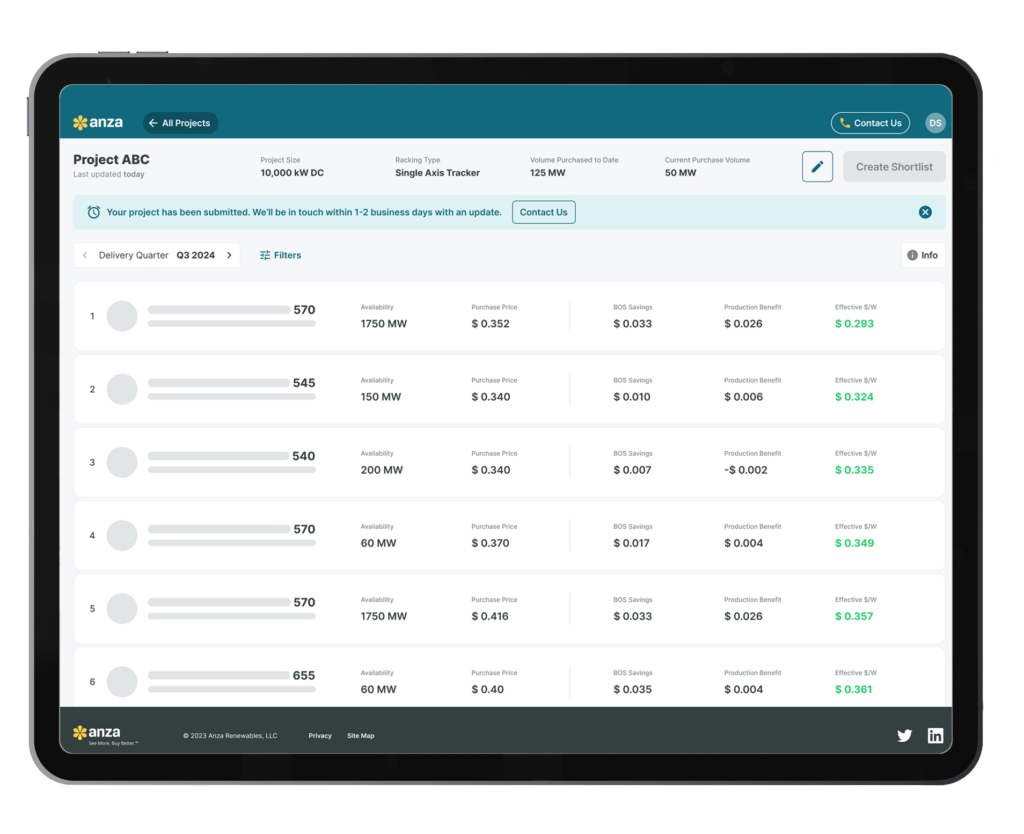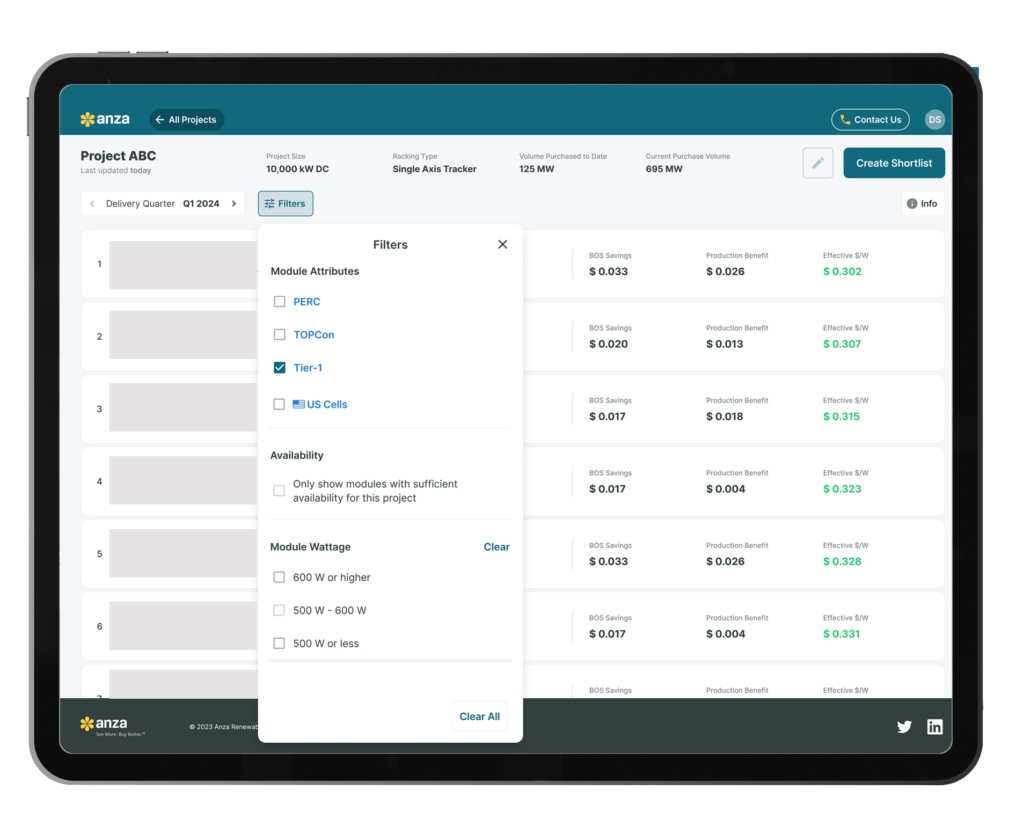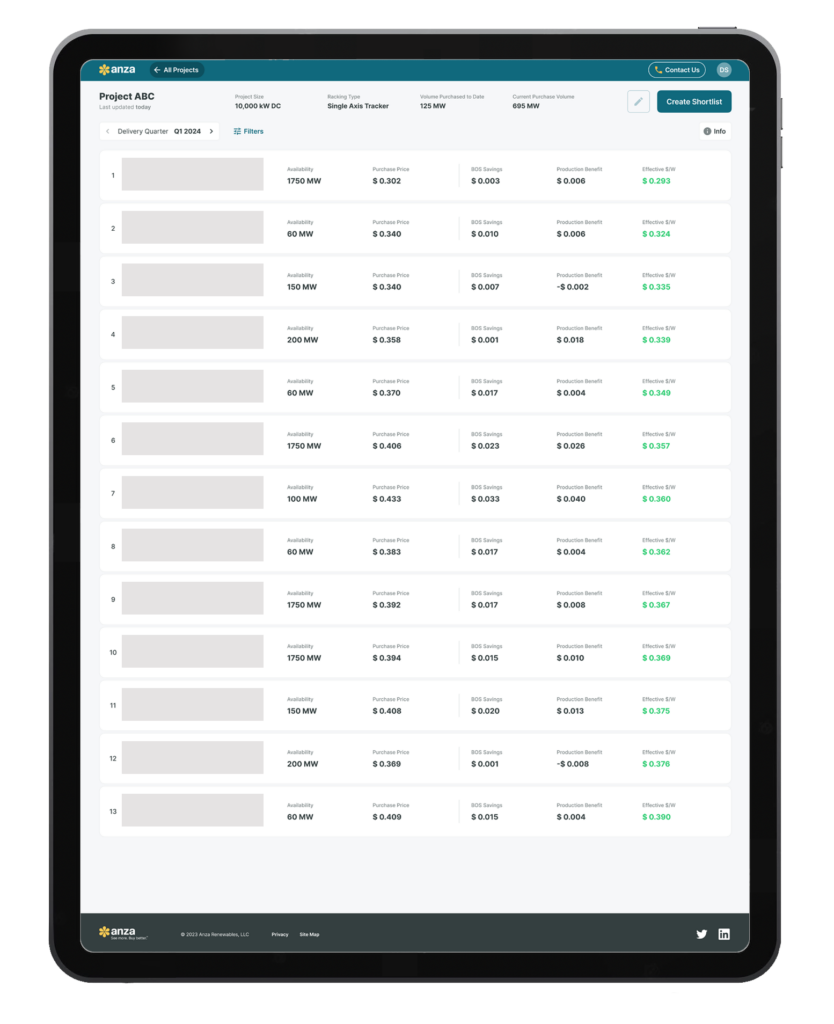We launched Anza to help buyers rapidly compare solar modules to make optimal project procurement decisions. We believe that putting better technology and data into the hands of procurement professionals is the only way to make that happen. We’re proud of our progress to date, the technology we’ve released, and the 2+ GW of solar procurements we’ve worked on. But we’re not resting on our laurels. We’re committed to continually investing in new technology to further increase our customers’ profits. With that in mind, we’re excited to share some of the improvements coming in our new release. This release includes a step change in our back end technology, an overhaul of our user interface and an exciting new metric that we believe has the ability to drastically improve procurement outcomes. In aggregate, these improvements will put even more power into the hands of procurement professionals, enabling you to further improve project profits.
What do the latest changes look like in the app? We heard that some of our terminology and calculations were difficult to understand without some face-to-face explanation. You’ll notice that we’ve updated our module ranking table and associated terminology so you can more easily evaluate modules by value and not just the lowest purchase price. As part of this, we are introducing our new metric: Anza’s Effective $/WattTM. We’ve also added the ability to dial in assumptions so you can ensure our calculations and results are appropriate for your project. Lastly, we’ve added advanced filtering so you can quickly narrow your selection based on your financial, technical and risk criteria.
Anza’s Effective $/Watt™️ and Other Ranking Table Terminology Changes

As part of this release, we are introducing an exciting new metric to the solar industry: Anza’s Effective $/Watt™️. Anza’s Effective $/Watt calculation allows buyers to rapidly compare module lifetime values using a single metric. Put simply, Effective $/Watt takes into account module price, energy production, and balance of system (non-module EPC) cost. On the surface, the metric is basic (that’s why we love it). However, comprehensive data and powerful technology are required to rapidly perform these calculations for multiple module options simultaneously. For the first time, buyers can quickly answer critical questions like how much more to pay for a more advanced cell technology or larger form factor module. With Anza, procurement professionals can now do what previously took procurement teams weeks and months in seconds. We aim to empower every module buyer to move beyond price and make decisions based on lifetime value.
Here are the definitions of Effective $/Watt and the other comparison metrics in the app in more detail. These will help you better utilize our data and technology when comparing products. In the new version of the app, you’ll see the following:
Anza’s Effective $/Watt™️
Effective $/Watt is calculated using the following formula:

The lowest Effective $/W creates the most value for your project.
Balance of System (BOS) Savings ($/W)
BOS, by definition, consists of the non-module equipment and labor for a solar installation. The savings come from comparing each module option to the set reference module.
Production Benefit ($/W)
Production Benefit shows the differences in module revenue from the differences in module production. Any differences in ITC value are included. These future cash flows are discounted to present value using the assumed discount rate. The benefit comes from comparing each module option to a reference module.
We are retiring the use of CapEx Delta ($), Revenue Delta ($) and NPV Delta ($).
As part of these ranking table changes, we also changed the reference module that each module option is compared to in the calculations. Previously, row one was the highest NPV (net present value) and the reference module. Every module option below the reference module had negative NPV values. Now, we’ve set the reference module to a theoretical module with median BOS costs and median performance. So modules with advantageous mechanical or electrical characteristics or superior performance will have higher positive BOS Savings or Production Benefits and lower Effective $/W than the reference module.
Advanced Module Filtering

We’ve added badges to each module product you may want to filter for. For example, you can filter for U.S. made cells, TopCon technology, BNEF Tier 1, or module watt class. Additionally, you can adjust the expected purchase quarter if you have flexibility, so you can find the most valuable option that meets your criteria and timeline.
Ability to Fine-Tune Project Variables

Our calculations are most meaningful to you if they are based on the variables specific to your project and business. You can now edit those variables in the app through our new advanced inputs functionality. Advanced inputs include:
- PPA terms, including the value of energy ($/kWh), escalation rate, discount rate, and term
- System details, including AC size and ground coverage ratio
- Indicating if the project is part of a portfolio
We hope that you’re as excited about these updates as we are for you to see them. Ready to test it out for yourself?


